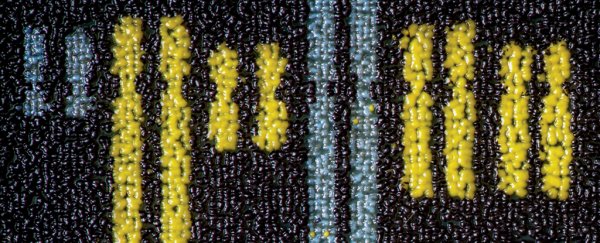For the first time, researchers have developed a new kind of software that makes it possible to genetically engineer, or 'program', a cell to perform any kind of function, via a simple programming language.
Biologists have been producing custom-made bacteria or other single cells organisms that can do useful things for us since 1973. For example, most of the human insulin given to diabetics today has been produced in a genetically modified version of either baker's yeast (Saccharomyces cerevisiae) or Escherichia coli (E. coli), and we've programmed bacteria to produce biofuel, and pump out antibiotics.
But while these kinds of tailored living cells could be useful in the future, it still takes time and effort to 'program' the cells to produce what we need. This new software should make the process much easier for biologists.
"Cells respond to their environment, make decisions, build structures, and coordinate tasks. Underlying these processes are computational operations performed by networks of regulatory proteins that integrate signals and control the timing of gene expression," the team from the Massachusetts Institute of Technology explains. "Harnessing this capability is critical for biotechnology projects that require decision-making, control, sensing, or spatial organisation."
The software is called Cello, and the team behind it hopes it will make programming a cell just as easy as programming a computer. As scientists attempt to do increasingly more complex things with living cells, these kinds of programs ideally simplify instructions to build and engineer more efficient cells.
"What we're finding over time is that biology isn't this kind of mysterious unpredictable substrate; it just felt that way because we didn't really have the tools to see what was going on," said Christopher Voigt, a synthetic biologist and lead researcher. "This is the first example where we've literally created a programming language for cells."
Basically, Cello lets you input your instructions, such as what kind of promoter you want to use and how you want the 'circuit' or program to run, and it will spit out a sequence for a DNA plasmid.
Plasmids are small, double-stranded DNA circles located in bacteria, and they have the unique ability of entering and exiting the main bacterial genome. This means that biologists can take these custom-made plasmids and use them to add external DNA into the genome, creating their ideal cell.
The project was a lot of work, with Voigt saying it took a decade of labour to produce. Unfortunately, engineering cells incorrectly can be just as unforgiving as omitting a line of code in a computer program. To avoid creating faulty cells, the team had to develop genetic components working together as an insulator to ensure that each sequence worked no matter where in the DNA sequence it was placed.
But the results speak for themselves: 92 percent of the 412 output states (finished products) functioned correctly, and 45 of the 60 resulting E. coli circuits produced using Cello worked perfectly, the researchers report.
As Erika Check Hayden explains for Nature, "[Voigt] estimates that it would take about a week to design 60 biological circuits with Cello; by contrast, it took a postdoc three years to design, test and build one successful biological circuit for a paper published in 2012."
You can actually go and play around on Cello, creating exciting new plasmids to put into your E. coli, but be warned - it might not make much sense unless you happen to be a programmer or a geneticist.
Either way, we are looking forward to seeing how this new technology can be used to create plenty of useful Franken-coli in the future.
This research was published in Science.
